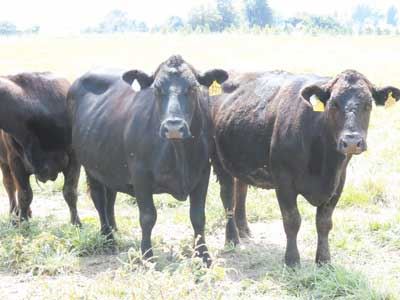Hair Shedding In Cattle Influenced By Both Genetics And The Environment
MT. VERNON, MO.
It is summertime in the Ozarks and the temperature and humidity are
rising. That can spell trouble for beef cattle that still haven’t shed
off their winter coats according to Eldon Cole, a livestock specialist
with University of Missouri Extension.
Like most traits, hair shedding is influenced by both genetics and the environment.
“In fescue country where the wild type of endophyte is prevalent, it
receives a lot of blame for long, heavy haircoats,” said Cole. “We’re
learning more about cattle’s genetic relation to long hair and heat
stress. When you put it all together, the slow shedders result in lower
rates of gain and reduced pregnancy rates.”
What can be done to get cattle to shed earlier before 80-degree weather arrives?
“You can be more observant and make an attempt to cull the slow
shedders. However, if a slow shedder breeds back promptly and raises a
good calf hold on to her,” said Cole.
When selecting a sire, either for natural service or artificial
insemination, consider the haircoat. Cole says there are significant
differences in haircoats and some AI companies rate that in their
catalog.
“Bulls that shed slowly tend to be lazy in the breeding pasture in
hot weather. In addition, they could have lower quality semen during and
after the heat stress period. Recent work shows embryo quality and
development could be affected by stress brought on by fescue toxins and
high-body temperature,” said Cole.
According to Cole, these are also reasons why, under most situations,
the spring-early summer breeding season should end in early July in hot
fescue country.

Two cows with obvious differences in hair shedding are grazing
the same fescue, yet the one on the left slicks off much more quickly.
Photo credit: MU Extension
SHEDDING EARLY
In 2014, a number of cattle producers have asked why their cattle
have shed off earlier. Some possible reasons could be that in the last
few years selection pressure has eliminated some slow shedders. Perhaps
sire selection is starting to reap the benefits of easier shedding.
“From the environmental side, we had an unusually cold and snowy
winter which could have resulted in more hair on the cattle so it
doesn’t make sense they would shed easier. The spring seemed to come
slower this year which again is opposite to the logical thinking about
shedding,” said Cole.
In addition, southwest Missouri fields have seen a bumper crop of
white clover this year. White clover and other legumes help dilute the
fescue toxin so Cole says this may be part of the answer.
“Little by little, we’ve seen a loss of pure fescue in many pastures.
This loss of pure pasture may be why the legumes are flourishing since
there is less competition from the fescue. Naturally, as the fescue
stand thins, cattle consume less of the toxin, ergovaline,” said Cole.
Many ideas have been proposed as to how to eliminate or minimize the
fescue toxin stress problem. Dilution with a non-toxic forage or
supplement helps. Dilution can be done with hay, concentrated feed like
dried distillers grains, corn gluten feed or a commercially prepared
feed. So far, Cole says there is no miracle additive that combats fescue
toxicity.
“I have some farmers who have resorted to clipping long hair off
their cattle. This may be a whole-body clip, but more than likely they
clip only along the topline, neck and shoulder area. Sometimes this
helps and other times it doesn’t show much benefit,” said Cole. ∆